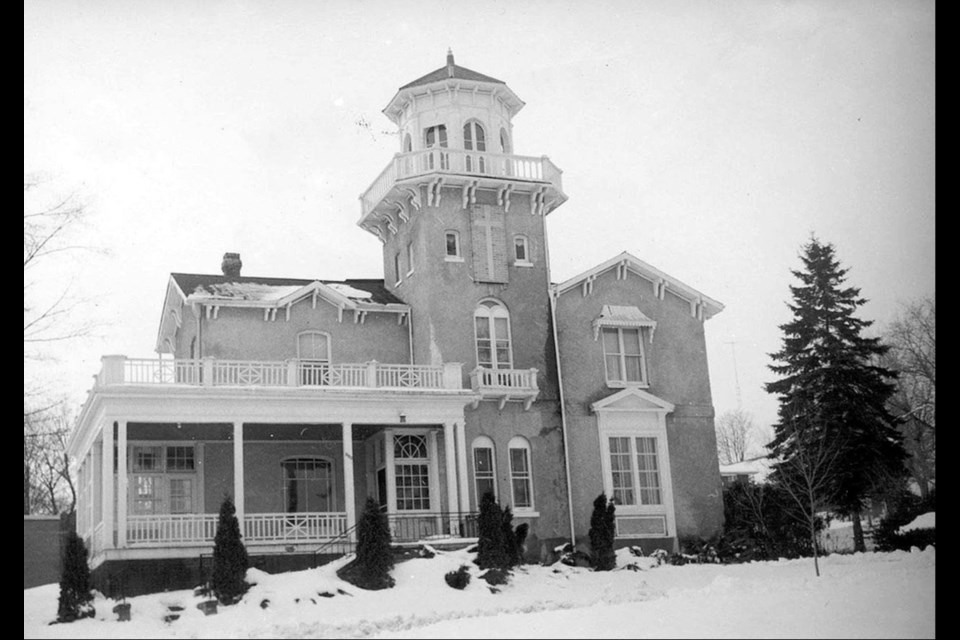As Christmas drew close, while I was cleaning the old glass in the doors leading to the sunroom, I thought of the many people over the years, starting in 1876, who had cleaned the glass in these doors.
The doors came from the home built by John MacLean Stevenson, of Bradford. (They were the front parlour windows facing Barrie Street.) It was a dignified residence for a former Bradford reeve, from 1871 to 1877. Ten months after it was built, the home was sold to the Robert Bingham family for $5,500. The Bingham family enjoyed living in the mansion for 16 years. On the death of Robert, Caroline, his widow, sold the house to James and Emily Boddy for $2,000. There was a depression at this time, and property values were very low.
James Boddy was another Bradford reeve, from 1894 to 1896. The Boddys lived in ‘Fairview’ until November 1903, when the house was sold under power of sale. The purchaser was Charlotte Jeffs, from Vancouver, for the sum of $1,900. As a speculator, she soon sold the mansion to Rev. Egerton Ryerson Young, who lived in ‘Algonquin Lodge.’ No other Canadian minister had been heard in more lands or had been honoured by citizens of more countries than Bradford’s E.R. Young. He was a lecturer, pastor, missionary and an author. He was ordained in Hamilton and, while on Christmas leave, he came to Bradford and married Libbie Bingham, daughter of Joseph Bingham (Esq.). It seemed only fitting that he came to live in Algonquin Lodge.
Young died in 1910, and his wife sold the mansion to Samuel Lukes on April 10, 1910, for $3,600.
The Lukes had been in residence in a home on the northwest corner of Holland and Church streets, where a plaza now stands, and, after selling to Dick Crake, they moved up to Barrie Street.
They called their home Luxalean, the name of the village the Lukes family came from in Wales.
While in residence, Sam made some repairs and replaced the verandas with a larger one and a top and bottom rail. The Lukes family owned the flour mill in the late 19th and early 20th centuries. The Lukes Mill was to old Bradford what the vegetable industry is to modern Bradford — one of the most important concerns in town. There were long lineups on Holland Street, horse-to-horse traffic jams waiting to use the mill. The old mill burned to the ground about 1967.
On Sam’s death, Luxalean was taken over by his son, Gilbert, on Feb. 26, 1929. According to Gilbert’s son, Tom Lukes, who lived in Wales, his father hired an architect in Toronto to make considerable alterations to the mansion. The driveway was altered, the front entrance was changed, the verandas were changed and a sunroom to the south of the music room was built. Artie Saint, a popular house and barn builder, was commissioned to do the work.
Lukes also had a double garage built off Moore Street (the former food bank) and a large stable near the garage.
On June 28, 1945, Gilbert sold a lot north of Luxalean to George Verkaik, of West Gwillimbury, for $5,500. This is the lot between the Stevenson Home (the old nursing home) and the mansion. In 1949, Mr. and Mrs. Lukes decided to sell the mansion. So, on Oct. 26, 1949, at the price of $19,000, the deed was transferred to the Roman Catholic Episcopal Corporation for the Diocese of Toronto. The home lost its laughter as the deed was again changed on Dec. 20, 1950, to the Ursuline Order of the Diocese of London in Ontario, a group of teaching nuns. With the sale of the property by Lukes, the grand terraced gardens to the south of the house also became a concrete driveway, ending an era of grandeur and spacious living.
Only the plot of land with the house was sold. The plot south of the home was kept, and St. Mary Catholic School was built.
With a change to the Catholic school board, there were only two sisters living in the mansion, so the for-sale sign went up again.
My father was the listing agent at the time and I was fortunate to be with Dad when he went to visit the nuns. I was in awe of the mansion. You could eat off the floors, and every room had a different design on the oak floors. The entrance and front hallways down and up were wallpapered with linen wall coverings and stencilled designs were around each door and window. Tom Lukes told me his mother had done the stencilling. Up in the widow’s walk, you could see for miles in every direction.
Mr. and Mrs. John Moniz bought the mansion on July 4, 1969, for $28,000. Contrary to zoning bylaws, the council at the time closed its eyes and allowed this grand house to be renovated to a multiple-family dwelling for 12 years.
On Feb. 10, 1981, the deed was again changed, to Mr. and Mrs. Fred Picavet. They hoped to renovate the mansion to its former grandeur, but a dispute that lasted a good 10 years saw the home falling apart, and we know the fate of the old mansion as it came under the wrecking ball and was totally destroyed.
Because of the many years I tried to save the mansion, I was contacted by the Bradford works of the time and told, if I wanted anything inside, to help myself, so now I have the glass doors and the upper bedroom doors installed in my home here in Prince Edward Island.
Even though the mansion is long gone, the doors are still being cleaned and, each time, I think of the unfortunate fate of the ‘Grand Old Dame’ of Bradford. Let’s hope historic Bradford will now be saved for future generations.
To take a virtual tour of the old mansion, visit youtube.com/watch?v=LrzgqzTJO9g.
